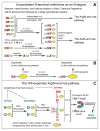The N-terminal methionine of cellular proteins as a degradation signal
- PMID: 24361105
- PMCID: PMC3988316
- DOI: 10.1016/j.cell.2013.11.031
The N-terminal methionine of cellular proteins as a degradation signal
Abstract
The Arg/N-end rule pathway targets for degradation proteins that bear specific unacetylated N-terminal residues while the Ac/N-end rule pathway targets proteins through their N(α)-terminally acetylated (Nt-acetylated) residues. Here, we show that Ubr1, the ubiquitin ligase of the Arg/N-end rule pathway, recognizes unacetylated N-terminal methionine if it is followed by a hydrophobic residue. This capability of Ubr1 expands the range of substrates that can be targeted for degradation by the Arg/N-end rule pathway because virtually all nascent cellular proteins bear N-terminal methionine. We identified Msn4, Sry1, Arl3, and Pre5 as examples of normal or misfolded proteins that can be destroyed through the recognition of their unacetylated N-terminal methionine. Inasmuch as proteins bearing the Nt-acetylated N-terminal methionine residue are substrates of the Ac/N-end rule pathway, the resulting complementarity of the Arg/N-end rule and Ac/N-end rule pathways enables the elimination of protein substrates regardless of acetylation state of N-terminal methionine in these substrates.
Copyright © 2014 Elsevier Inc. All rights reserved.
Figures







Comment in
-
Crosstalk between the Arg/N-end and Ac/N-end rule.Cell Cycle. 2014;13(9):1366-7. doi: 10.4161/cc.28751. Epub 2014 Apr 3. Cell Cycle. 2014. PMID: 24698805 Free PMC article. No abstract available.
Similar articles
-
The N-end rule pathway and regulation by proteolysis.Protein Sci. 2011 Aug;20(8):1298-345. doi: 10.1002/pro.666. Protein Sci. 2011. PMID: 21633985 Free PMC article. Review.
-
N-terminal methionine excision of proteins creates tertiary destabilizing N-degrons of the Arg/N-end rule pathway.J Biol Chem. 2019 Mar 22;294(12):4464-4476. doi: 10.1074/jbc.RA118.006913. Epub 2019 Jan 23. J Biol Chem. 2019. PMID: 30674553 Free PMC article.
-
Control of mammalian G protein signaling by N-terminal acetylation and the N-end rule pathway.Science. 2015 Mar 13;347(6227):1249-1252. doi: 10.1126/science.aaa3844. Science. 2015. PMID: 25766235 Free PMC article.
-
Control of Hsp90 chaperone and its clients by N-terminal acetylation and the N-end rule pathway.Proc Natl Acad Sci U S A. 2017 May 30;114(22):E4370-E4379. doi: 10.1073/pnas.1705898114. Epub 2017 May 17. Proc Natl Acad Sci U S A. 2017. PMID: 28515311 Free PMC article.
-
[Progress on the role of N-end rule pathways in protein degradation].Sheng Li Xue Bao. 2024 Dec 25;76(6):987-1000. Sheng Li Xue Bao. 2024. PMID: 39780575 Review. Chinese.
Cited by
-
Degradation of Serotonin N-Acetyltransferase, a Circadian Regulator, by the N-end Rule Pathway.J Biol Chem. 2016 Aug 12;291(33):17178-96. doi: 10.1074/jbc.M116.734640. Epub 2016 Jun 23. J Biol Chem. 2016. PMID: 27339900 Free PMC article.
-
N-terminal acetylation and the N-end rule pathway control degradation of the lipid droplet protein PLIN2.J Biol Chem. 2019 Jan 4;294(1):379-388. doi: 10.1074/jbc.RA118.005556. Epub 2018 Nov 13. J Biol Chem. 2019. PMID: 30425097 Free PMC article.
-
N-degron and C-degron pathways of protein degradation.Proc Natl Acad Sci U S A. 2019 Jan 8;116(2):358-366. doi: 10.1073/pnas.1816596116. Proc Natl Acad Sci U S A. 2019. PMID: 30622213 Free PMC article. Review.
-
Change in the graphics of journal articles in the life sciences field: analysis of figures and tables in the journal "Cell".Hist Philos Life Sci. 2022 Aug 2;44(3):33. doi: 10.1007/s40656-022-00516-9. Hist Philos Life Sci. 2022. PMID: 35918565 Free PMC article.
-
N-Terminal Acetylation Stabilizes SIGMA FACTOR BINDING PROTEIN1 Involved in Salicylic Acid-Primed Cell Death.Plant Physiol. 2020 May;183(1):358-370. doi: 10.1104/pp.19.01417. Epub 2020 Mar 5. Plant Physiol. 2020. PMID: 32139475 Free PMC article.
References
-
- Arnesen T, Van Damme P, Polevoda B, Helsens K, Evjenth R, Colaert N, Varhaug JE, Vandekerckhove J, Lillehaug JR, Sherman F, et al. Proteomics analyses reveal the evolutionary conservation and divergence of N-terminal acetyltransferases from yeast to humans. Proc Natl Acad Sci USA. 2009;106:8157–8162. - PMC - PubMed
-
- Bachmair A, Finley D, Varshavsky A. In vivo half-life of a protein is a function of its amino-terminal residue. Science. 1986;234:179–186. - PubMed
-
- Behnia R, Panic B, Whyte JRC, Munro S. Targeting of the Arf-like GTPase Arl3p to the Golgi requires N-terminal acetylation and the membrane protein Sys1p. Nat Cell Biol. 2004;6:405–413. - PubMed
-
- Choi WS, Jeong BC, Joo YJ, Lee MR, Kim J, Eck MJ, Song HK. Structural basis for the recognition of N-end rule substrates by the UBR box of ubiquitin ligases. Nat Struct Mol Biol. 2010;17:1175–1181. - PubMed
Publication types
MeSH terms
Substances
Grants and funding
LinkOut - more resources
Full Text Sources
Other Literature Sources
Molecular Biology Databases
Research Materials

